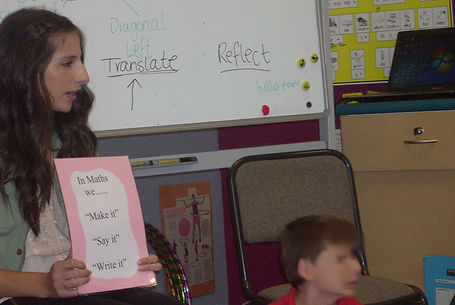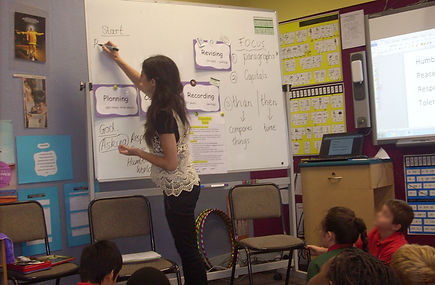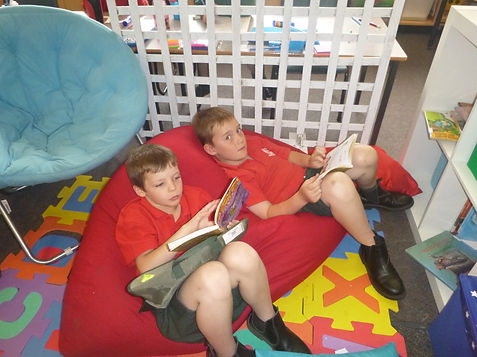Sandra Cultrera
Primary School Teacher
4. Create and maintain supportive & safe learning environments
I strongly believe that in order to create and maintain supportive and safe learning environments in and outside the classroom, I need to model expectations for learning and behaviour that are required for everyone to function in harmony with each other. If I make this a focus for my student body through everyday practice, it will become habitual participatory practice for my students.
I create supportive and safe learning environments by:
-
Making consistent and understood learning focuses.
-
Providing guidance and reassurance.
-
Use Reflective Practice, for students and myself.
-
Praise for little successes and improvement.
-
Modelling respect in all aspects of classroom & school environment.
-
Articulate Rights and Responsibilities.
-
Encourage risk taking and the importance of choices.
Setting Clear, Consistent Expectations and Goals
-
In regards to effective learning outcomes, I found that setting clear expectations and goals for my grade 5 and 6 students before a lesson, resulted in high achieving results for each individual child no matter which level they were at in their personal learning. It gives students encouragement and a level of work that is expected for their year level.
-
This was particularly effective for grades 5 and 6 as it guided them into going beyond general expectations and pushing themselves to do their very best. This process takes time and needs to incorporated into everyday practice in order to become common knowledge for students. However, this common practice resulted in the creation of intrinsic motivation.
-
In some instances, I used children's work examples from previous lessons to show as an example, in particular those who modeled the expectation I set. It is extremely rewarding to witness students, in particular those who are below standard, to try their very best and gain initiative to go further in their learning.
-
If I support all students by setting expectations and clear, focused learning goals, I believe I will receive the best possible results from individual students.
Reflective Practice
-
Getting students to reflect on learning sessions, in particular mathematics and physical, personal, social learning sessions, allows for the creation of an open, honest atmosphere whereby students feel comfortable expressing their learning and feelings, and therefore have the opportunity to learn off one another.
-
A useful too that I used to initiate reflection time was 'Reflection Cards' and for Maths 'Make, Say, Write' card. The reflection cards gave students opening sentences that they could finish in their own words. The Maths 'Make, Say, Write' card was a process of concluding the session by verbalizing what we had to 'make' or the task that we completed, then 'say' or verbalize what we did and what we learnt, then students 'write' this in their workbooks to consolidate their reflection.
-
Reflection time also required students to ask themselves questions such as 'why' and 'how', as they were grade 5 and 6, as to go deeper with their responses.
-
Reflection time also gave me an opportunity to gain insight into certain activities and student feelings and learning outcomes so that I could then reflect on creating and structuring certain activities for upcoming sessions.
Modeling Respect and Consideration
-
Using appropriate language to one another in the classroom and school
-
Making good use of listening skills, and the ways in which we show others that we are listening
-
Using empathy in certain social situations
-
Treat others the way you would like to be treated motto
Flexibility, Experimentation during lessons
-
I like to plan and organise my teaching and learning sessions, however I am very flexible to change during sessions when the unexpected occurs, for example: students interpretation of a task is varied. For a situation like this, I bring all students back together, or create a small focus group on the carpet, in order to touch base with students about their focus or any difficulty understanding the task. Not only does this support students, but gives them opportunities to help each other and offer an alternative way of comprehending rather a task rather than solely hearing myself as the teacher.
-
I enjoy experimenting with a range of learning styles when presenting my lessons. I am a visual and verbal learner myself and always make great use of visuals within the classroom, however when observing students as a whole, I begin to understand what they best respond to. Therefore I try to use more than the Visual aspect to learning, but also kinesthetic learning, getting students up and moving, for example: moving our bodies to demonstrate coordinates on a quadratic graph.
Growth Mindsets
In my classroom's that I have taught in, I have applied the Growth Mindsets by psychologist Carol Dweck. This practice believes that all students have the capacity to learn, however their personal 'mindsets' (belief systems) that contain unconscious rules and values in regards to how an individual views their own capacity to learn and attitude towards self efficacy. With Anxiety becoming a more recognised issue within classrooms, working towards identifying 'Fixed Mindsets' whereby intelligence appears fixed, mistakes are covered up at all costs, avoid learning opportunities that they believe they cannot achieve simply because a student says 'I can't' and ignore constructive criticism. Therefore, I use, and in some instances have explicitly taught Growth Mindsets which involves constant encouragement to approach challenges in a positive manner, eliminating fear from mistakes and putting emphasis on process rather than end result. Language that I establish when teaching through Growth Mindsets includes: I'm so impressed the way you were thinking, great effort, try again, you tried really hard. Fixed mindsets are not generic but can be subject specific, therefore I identified in my grade 5/6 class that half of the girls within the classroom possessed a fixed mindset in regards to Maths being too hard and that they could not do it.






No Putdown Policy!
At the beginning of all of my teaching rounds, in particular my fourth year placement, I made it clear to my student body that I believe in a ‘No Putdown’ policy within the classroom. This was made apparent to students during everyday classroom activity, in particular during group work, assignment presentations, and whole group discussion on the floor. This allowed myself to keep on top of any bullying that arose and most of all created a safe and trusting relationship with myself and the student body. I believe that children should know that their teacher will keep them safe within the classroom and remain a consistent figure in regards to bullying. Applying this steadfast rule that I am very passionate about also allowed for children to take risks with their own personal learning as they were not afraid to have a go at answering questions that were unsure of and knew that it was acceptable to make mistakes in front of class mates. This simple policy creates empathy and consideration among students and fosters harmonious classroom atmosphere.
One of the most important beliefs that I have is the vitality of setting up a collaborative community of thinkers and learners. This involves building relationships with the students and assisting them in building relationships with each other. It also involves giving students responsibility over their own learning and positions and possessions in the classroom in order for them to feel valued, trusted and proud. I did this at the beginning of a new year and the results from this continual process by the end of term one were astounding.
The expectation was set that within the learning space everyone would be able to make decisions and voice ideas as a community within our classroom and that it was expected that we listen and think about these decisions that we make. I allowed the students to choose where they sit, what they wished to have on their table that was going to assist their learning and design their labels for their tubs so that they could identify them. This made the room feel as though it was theirs and they had some responsibility. They had their items labelled and were allowed a pencil case on their table or a cup. This in itself minimised the amount of lost pencils, sharpeners, rubbers and other items as it was their responsibility.
As we built up our community through circle time and various anchor charts on what it means to be a great classmate, I began noticing that students begun sharing their equipment with the intention that they were still respecting items that were not theirs.
Other expectations set in our classroom promise to each other was that we could make mistakes, ask questions and ask for help from myself ad from each other. We acted scenarios out of what this looked liked, especially as everyone has different talents and learn differently. With these expectations also came a rule: if you couldn’t make the right choice about where to sit or how to conduct ones self in the classroom, that choice would be made for you.
This allowed the students to not solely think of tasks and the content that they were doing, but how they were doing them and why.
This was the key to creating confident and independent thinkers and learners. Term one, I believe is the time to set up this confidence and the beginning of students thinking metacognitively. Every child felt safe, valued, appreciated and responsible all at their own personal and intellectual level.
Creating a criteria for tasks, especially those that involved a procedure, develops a sense of safetly if children forget and need to double check what the task requires of them. It also encourages them to think about if they ae wandering off task and need to get back on it. This guided and directed students in a way that they felt confident and could ask for clarification at any time. These criteria could be done for any task and were put in the childrens own language and decided on as a group.
Tackling Challenging Behaviour
Not all children cope with responsibility well and can crack under pressure, particularly when they feel inadequate. The differentiation of learning tasks usually takes this frustration away, however this doesn’t always work. Putting a child’s actions in their hands along with consequences allows them choice, allowing them to pretty quickly visualise the correct choices for them. I always had in some place within my classroom a space that was private that children could ‘cool off’ in whilst making their choices about what they were going to do. If they couldn’t come to a reasonable conclusion, I would step in and simply explain to them that I’ve had to make a choice for them until they were ready to do so for themselves.
Tackling behaviour I believe should be kept calm and between teacher, student and anyone involved, not on public display for the rest of the class to witness.
Approaching a student about their behaviour should not be face to face but on their side so that they feel safe and as though they are not going to be attacked.
Third year practicum, 2013.

